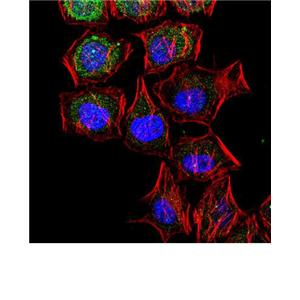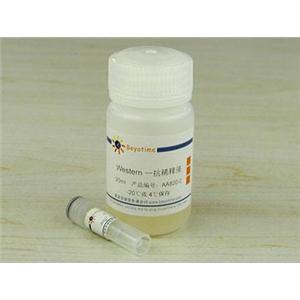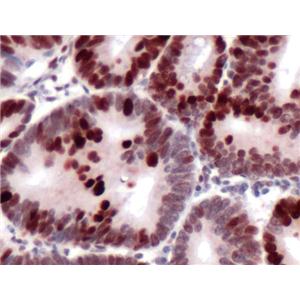产品概述
| 产品名称(Product Name) | TSLC1 Rabbit Polyclonal Antibody |
| 描述(Description) | Rabbit Polyclonal Antibody |
| 宿主(Host) | Rabbit |
| 应用(Application) | WB,IF-P,IF-F,ICC/IF,ELISA |
| 种属反应性(Reactivity) | Human,Mouse |
产品性能
| 偶联物(Conjugation) | Unconjugated |
| 修饰(Modification) | Unmodified |
| 同种型(Isotype) | IgG |
| 克隆(Clonality) | Polyclonal |
| 形式(Form) | Liquid |
| 存放说明(Storage) | Store at 4°C short term. Aliquot and store at -20°C long term. Avoid freeze/thaw cycles. |
| 储存溶液(Buffer) | Liquid in PBS containing 50% glycerol, 0.5% BSA and 0.02% New type preservative N. |
| 纯化方式(Purification) | Affinity purification |
免疫原
| 基因名(Gene Name) | CADM1 |
| 别名(Alternative Names) | CADM1; IGSF4; IGSF4A; NECL2; SYNCAM; TSLC1; Cell adhesion molecule 1; Immunoglobulin superfamily member 4; IgSF4; Nectin-like protein 2; NECL-2; Spermatogenic immunoglobulin superfamily; SgIgSF; Synaptic cell adhesion molecule; SynCAM; Tumo |
| 基因ID(Gene ID) | 23705 |
| 蛋白ID(SwissProt ID) | Q9BY67 |
产品应用
| 稀释比(Dilution Ratio) | WB 1:500-1:2000, IF-P/IF-F/ICC/IF 1:200-1:1000, ELISA 1:20000.Not yet tested in other applications. |
| 蛋白分子量(Molecular Weight) | 49kDa |
研究背景
disease:Absent or down-regulated in many advanced cases of NSCLC as well as in many other human cancers, due to gene silencing by promoter methylation.,domain:The cytoplasmic domain appears to play a critical role in proapoptosis and tumor suppressor activity in NSCLC.,function:Mediates homophilic cell-cell adhesion in a Ca(2+)-independent manner. Also mediates heterophilic cell-cell adhesion with CADM3 and PVRL3 in a Ca(2+)-independent manner. Acts as a tumor suppressor in non-small-cell lung cancer (NSCLC) cells. Interaction with CRTAM promotes natural killer (NK) cell cytotoxicity and interferon-gamma (IFN-gamma) secretion by CD8+ cells in vitro as well as NK cell-mediated rejection of tumors expressing CADM3 in vivo. May contribute to the less invasive phenotypes of lepidic growth tumor cells. In mast cells, may mediate attachment to and promote communication with nerves. CADM1, together with MITF, is essential for development and survival of mast cells in vivo. May act as a synaptic cell adhesion molecule that drives synapse assembly. May be involved in neuronal migration, axon growth, pathfinding, and fasciculation on the axons of differentiating neurons. May play diverse roles in the spermatogenesis including in the adhesion of spermatocytes and spermatids to Sertoli cells and for their normal differentiation into mature spermatozoa.,similarity:Belongs to the nectin family.,similarity:Contains 1 Ig-like V-type (immunoglobulin-like) domain.,similarity:Contains 2 Ig-like C2-type (immunoglobulin-like) domains.,subcellular location:Associates with perinuclear and plasma membranes in vivo. Localized to the basolateral plasma membrane of epithelial cells in gall bladder.,subunit:Homodimer. Interacts with CRTAM and EPB41L3/DAL1. The interaction with EPB41L3/DAL1 may act to anchor CADM1 to the actin cytoskeleton. Interacts via its C-terminus with the PDZ domain of MPP3 and the PDZ domain of MPP6.,disease:Absent or down-regulated in many advanced cases of NSCLC as well as in many other human cancers, due to gene silencing by promoter methylation.,domain:The cytoplasmic domain appears to play a critical role in proapoptosis and tumor suppressor activity in NSCLC.,function:Mediates homophilic cell-cell adhesion in a Ca(2+)-independent manner. Also mediates heterophilic cell-cell adhesion with CADM3 and PVRL3 in a Ca(2+)-independent manner. Acts as a tumor suppressor in non-small-cell lung cancer (NSCLC) cells. Interaction with CRTAM promotes natural killer (NK) cell cytotoxicity and interferon-gamma (IFN-gamma) secretion by CD8+ cells in vitro as well as NK cell-mediated rejection of tumors expressing CADM3 in vivo. May contribute to the less invasive phenotypes of lepidic growth tumor cells. In mast cells, may mediate attachment to and promote communication with nerves. CADM1, together with MITF, is essential for development and survival of mast cells in vivo. May act as a synaptic cell adhesion molecule that drives synapse assembly. May be involved in neuronal migration, axon growth, pathfinding, and fasciculation on the axons of differentiating neurons. May play diverse roles in the spermatogenesis including in the adhesion of spermatocytes and spermatids to Sertoli cells and for their normal differentiation into mature spermatozoa.,similarity:Belongs to the nectin family.,similarity:Contains 1 Ig-like V-type (immunoglobulin-like) domain.,similarity:Contains 2 Ig-like C2-type (immunoglobulin-like) domains.,subcellular location:Associates with perinuclear and plasma membranes in vivo. Localized to the basolateral plasma membrane of epithelial cells in gall bladder.,subunit:Homodimer. Interacts with CRTAM and EPB41L3/DAL1. The interaction with EPB41L3/DAL1 may act to anchor CADM1 to the actin cytoskeleton. Interacts via its C-terminus with the PDZ domain of MPP3 and the PDZ domain of MPP6.,
研究领域
Cell adhesion molecules (CAMs);





